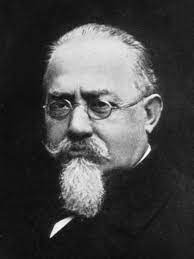Lombroso, Cesare

Bio: (1835-1909) Italian criminologist. Cesare Lombroso was a doctor by education, with a specialization in surgery. He taught at the University of Turin but also worked as a doctor in the Italian army and civilian hospitals. His study of people with mental illness directed Lombroso to study the relationship between inherited biological factors and behavior. He was heavily influenced by Charles Darwin's theory of biological evolution and Herbert Spencer's theory of social evolution. Lombroso, together with his younger associates Enrico Ferri and Raffaele Garofalo, is considered one of the founders of Italian and world criminology. Lombroso was very attached to the positivist method and measurements, so, for the sake of researching his theory, he made extensive measurements of the body and face dimensions of hundreds of criminals and members of the general population.
In the book Criminal Man (2006, in Italian 1876), he concludes that free will does not have a great influence on criminal behavior, but that such behavior is a product of evolutionary atavism that creates primitive or sub-human nature in individuals. These individuals are characterized by a specific shape of the head and bone structure, a tendency towards slang, tattoos, and vices, and all these features form the basis of a criminal personality. In addition to this group of born criminals, Lombroso singled out a group of occasional or accidental criminals. There are three sub-groups of criminals in this group: random criminals, criminals who are that because of their social ties to born criminals, and "criminaloids" who are only partially biologically degenerate.
Lombroso is also the first criminologist to deal with women criminals, so in his book The Female Offender (2015, in Italian 1895) he argues that biology does not play a significant role in women, as a cause of crime. However, women whose biology influenced them to become criminals were more vicious criminals than male criminals. He believed that women have less moral sense than men, but that motherhood, lack of passion, piety, and lack of intelligence prevent them from committing crimes. In his later works, he accepted the criticism that his theory deterministically determines criminal behavior only through biological predisposition, so he introduced other factors into his criminological theory. This revised view sees gender, age, poverty, and occupation as factors that are also influencing the likelihood of individual criminal behavior.
Fields of research
Anthropology Body Evolution Free Will Health Human Nature Morality Personality Poverty Professions Prostitution CrimeTheoretical approaches
EvolutionismMain works
Genio e follia (1864);
L’Uomo Delinquente (1876);
Le più recenti scoperte ed applicazioni della psichiatria ed antropologia criminale (1894);
La donna criminale (1895);
Genio e degenerazione (1897);
Le crime, causes et remédes (1899)
Nuovi studii sul genio (1902).
Works translated into English:
Criminal Woman, the Prostitute, and the Normal Woman (2004);
Criminal Man (2006, in Italian 1876);
Crime, Its Causes and Remedies (2009);
The Female Offender (2015, in Italian 1895);
After Death--What?: Spiritistic Phenomena and Their Interpretation (2015);
The Man Of Genius (2018);
Criminal Man: According to the Classification of Cesare Lombroso (2021).

